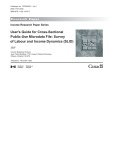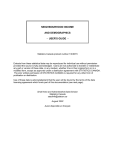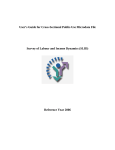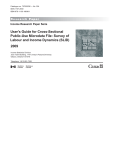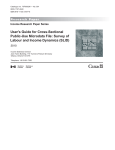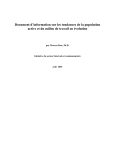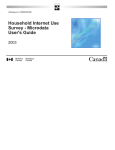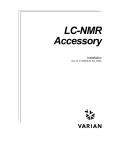Download Income Trends in Canada 1980
Transcript
75F0002MIE - 00001 Income Trends in Canada 1980-1997 User’s Guide Prepared by: Réjean Lasnier January 2000 Data in many forms Statistics Canada disseminates data in a variety of forms. In addition to publications, both standard and special tabulations are offered. Data are available on the Internet, compact disc, diskette, computer printouts, microfiche and microfilm, and magnetic tape. Maps and other geographic reference materials are available for some types of data. Direct online access to aggregated information is possible through CANSIM, Statistics Canada’s machine-readable database and retrieval system. How to obtain more information Inquiries about this product and related statistics or services should be directed to: Client Services Income Statistics Division Canada, Ottawa, Ontario, K1A 0T6 ((613) 951-7355; (888) 297-7355; [email protected]) or to the Statistics Canada Regional Reference Centre in: Halifax Montréal Ottawa Toronto Winnipeg (902) (514) (613) (416) (204) 426-5331 283-5725 951-8116 973-6586 983-4020 Regina Edmonton Calgary Vancouver (306) (403) (403) (604) 780-5405 495-3027 292-6717 666-3691 You can also visit our World Wide Web site: http://www.statcan.ca Toll-free access is provided for all users who reside outside the local dialing area of any of the Regional Reference Centres. National enquiries line National telecommunications device for the hearing impaired Order-only line (Canada and United States) 1 800 263-1136 1 800 363-7629 1 800 267-6677 Ordering/Subscription information All prices exclude sales tax Catalogue no. 75F0002MIE-00001, is available on internet for CDN $0.00 per issue. Users can obtain single issues at http://www.statcan.ca/cgi-bin/downpub/freepub.cgi. Standards of service to the public Statistics Canada is committed to serving its clients in a prompt, reliable and courteous manner and in the official language of their choice. To this end, the agency has developed standards of service which its employees observe in serving its clients. To obtain a copy of these service standards, please contact your nearest Statistics Canada Regional Reference Centre. Statistics Canada Income Statistics Division Income Trends in Canada 1980-1997 User's Guide Published by authority of the Minister responsible for Statistics Canada © Minister of Industry, 1999 All rights reserved. No part of this publication may be reproduced, stored in a retrieval system or transmitted in any form or by any means, electronic, mechanical, photocopying, recording or otherwise without prior written permission from Licence Services, Marketing Division, Statistics Canada, Ottawa, Ontario, Canada K1A 0T6. January 2000 Catalogue no. 75F0002MIE - 00001 ISSN 0000-0000 Catalogue no. 75F0002MPE - 00001 ISSN 0000-0000 Frequency: Irr. Ottawa La version française de cette publication est disponible sur demande Note of appreciation Canada owes the success of its statistical system to a long-standing partnership between Statistics Canada, the citizens of Canada, its businesses, governments and other institutions. Accurate and timely statistical information could not be produced without their continued co-operation and goodwill. Income trends in Canada (1980-1997) – User’s guide Abstract: This user’s guide provides a detailed description of a new CD-ROM Income Trends in Canada (13F0022XCB). It also provides a glossary, a description of the major concepts as well as an overview of the data source, the Survey of Consumer Finances. Income Trends in Canada (1980-1997) contains 48 cross-classified income tables, covering the period 1980 to 1997. Most tables include estimates for Canada, the 10 provinces and 15 census metropolitan areas (CMAs). Major topics included in the tables are income distributions and inequality, earnings of men and women, income tax, government transfers, low income and sources of income. More, Beyond 20/20 software used in this product allows users to execute very easily common tasks done by analysts and researchers: browse rapidly data, select data of interest, graph or map them or simply save them in a worksheet. Then, from instantaneous graph, it is very easy to find out trends and pull out highlights. Note: Income Trends in Canada replaces Income Historical Review, 1980-1996. TABLE OF CONTENTS 1. Introduction .................................................................................... 7 2. What’s New? .................................................................................. 8 2.1 Six New Tables ........................................................................ 8 2.2 Provincial and Metropolitan Data................................................. 8 2.3 New Groupings for Tables ......................................................... 9 2.4 New Table Titles and Numbers ................................................. 10 3. The Tables ................................................................................... 11 3.1 Table Titles............................................................................ 11 3.2 List of Abbreviations................................................................ 16 4. Getting Started............................................................................. 18 5. Overview of the Survey of Consumer Finances .......................... 19 6. Income Concepts ......................................................................... 20 7. Family and Other Key Concepts .................................................. 25 8. Low Income Cutoffs Defined........................................................ 28 9. Data Reliability and Suppression................................................. 29 10. Concordance Table between Last Edition and This Edition........ 31 11. Plans for Future Editions ............................................................. 33 12. Questions and Comments ........................................................... 34 Appendix I – On Poverty and Low Income ........................................ 35 Appendix II – How to Order Income Trends in Canada..................... 39 1. Introduction Income Trends in Canada is an extensive collection of income statistics on CD-ROM, covering topics such as income distributions, income tax, government transfers, and low income. These income estimates are derived from the Survey of Consumer Finances (SCF) and cover 1980 to 1997. For 1998 onward, the Survey of Labour and Income Dynamics (SLID) will replace SCF and future editions of this product will include SLID as well as SCF data. This guide contains a brief overview of SCF, as well as the concepts and definitions underlying the data. Income Trends in Canada uses Version 5.1 of the Beyond 20/20 Browser software for accessing and manipulating tables. See Getting Started for more information. To order a copy of Income Trends in Canada, please refer to the appendix of the present guide. Statistics Canada 7 75F0002M - 00001 2. What’s New? Income Trends in Canada replaces Income Historical Review, 1980-1996. Users familiar with the predecessor product will know that it contained 42 tables. Six new tables have been added. Most tables now include estimates for the 10 provinces and for 15 census metropolitan areas (CMAs). And of course, another year of data (1997) has been added to the tables. Several other changes make it easier to navigate through this very large database combining well over two million data points. A description of the changes follows. 2.1 Six New Tables Four new tables present estimates of market income, that is, earnings plus investment income and income from retirement pensions. The other two new tables display information on government transfers and income taxes paid. These tables provide averages, rates and shares of the total by after-tax income quintiles. All tables provide estimates for various subgroups of the population. 2.2 Provincial and Metropolitan All but one of the 48 tables now include provincial data. Forty tables also present estimates for the 15 largest CMAs in Canada, listed below. Users should note that this massive increase in content entails some suppression, due to small sample sizes. See Data Reliability and Suppression for more information. Statistics Canada 8 75F0002M - 00001 The CMAs covered in Income Trends in Canada are Halifax, Québec, Montréal, Ottawa – Hull, Toronto, St-Catharines – Niagara, Hamilton – Burlington, Kitchener – Waterloo, London, Windsor, Winnipeg, Calgary, Edmonton, Vancouver and Victoria. 2.3 New Groupings for Tables A “step by step” classification scheme groups tables into eight series, as follows: Series 100 – Earnings This is income from employment, which represents the greatest portion of income for most people. Series 200 – Market income Also known as “income before transfers”, market income is the sum of earnings plus income from investments and retirement pensions. Series 300 – Government transfers Income received from programs instituted by the different levels of government. Series 400 – Total income The sum of market income and government transfers. Series 500 – Income tax The amount paid in federal and provincial income taxes. Series 600 – Income after tax This is defined as total income minus income tax paid. Series 700 – Multiple income concepts Tables in this series include data based on several income concepts, for example, total income and after-tax income. Statistics Canada 9 75F0002M - 00001 Series 800 – Low income This series covers low income cutoffs (LICOs), low income estimates and rates. 2.4 New Table Titles and Numbers Table numbers now reflect the new series. More importantly, the table titles and descriptions are now clearer and more meaningful. Users wishing to compare last year's tables with this year's can consult the section entitled Concordance Table between Last Edition and This Edition. Statistics Canada 10 75F0002M - 00001 3. The Tables 3.1 Table Titles Each table has a short and long name. Every effort has been made to make the titles meaningful. However, both short and long titles are constrained in the number of characters they can use. Several abbreviations are necessary. The table below contains the short and long table titles. Section 3.2 has a list of commonly used abbreviations. Series 100 – Earnings No. 101 102 103 104 105 Short title Distribution of earners x earnings x sex Long title Distribution of earners by earnings and sex, Can, prov & CMAs, 1980 to 1997, current and constant (1997) dollars Avg earnings, fem/male Average earnings and female/male earnings ratios earnings ratios x work by work activity, Can, prov & CMAs, 1980 to activity 1997, constant (1997) dollars Number of earners x sex x Number of earners by sex and work activity, Can, work activity prov & CMAs, 1980 to 1997, constant (1997) dollars Fem/male earnings ratios x Female/male earnings ratios by age, education and age, educ, marital status marital status, Can, prov & CMAs, 1980 to 1997 Dist of dual, single and no Dist and average total income of dual earn, single earn husband/wife fam earn, no earn for husband/wife fam, Can, prov & CMAs, 1980 to 1997, constant (1997) dollars Series 200 – Market income No. 201 202 Short title Market income, distribution of economic families (EF) Long title Market income, distribution of economic families, Can, prov & CMAs, 1980 to 1997, current and constant (1997) dollars Market income, distribution Market income, distribution of unattached of unattached individuals (UI) individuals, Can, prov & CMAs, 1980 to 1997, current and constant (1997) dollars Statistics Canada 11 75F0002M - 00001 203 Market income, distribution of EF+UI 204 Market income, distribution of EF, UI, EF+UI Market income, distribution of EF+UI, Can, prov & CMAs, 1980 to 1997, current and constant (1997) dollars Market income, distribution of EF, UI, EF+UI, Can, prov & CMAs, 1980 to 1997, constant (1997) dollars Series 300 – Government transfers No. 301 Short title Gov transfers x IAT quintiles for EF, UI, EF+UI Long title Government trans by IAT quintiles for EF, UI, EF+UI: Avg trans, rates of trans, shares of aggregate trans, Can & prov, 1980 to 1997, constant (1997) dollars Series 400 – Total income No. 401 Short title Total income, distribution of economic families (EF) 402 Total income, distribution of unattached individuals (UI) 403 Total income, distribution of EF+UI 404 Total income, distribution of EF, UI, EF+UI 405 Total income, distribution of individuals (IND) 406 Avgs: TI, inc/cap, fam size, nbr: children & recip for EF Statistics Canada Long title Total income, distribution of economic families, Can, prov & CMAs, 1980 to 1997, current and constant (1997) dollars Total income, distribution of unattached individuals, Can, prov & CMAs, 1980 to 1997, current and constant (1997) dollars Total income, dist of economic families and unattached individuals together, Can, prov & CMAs, 1980 to 1997, current and constant (1997) dollars Total income, distribution of EF, UI, EF+UI, Can, prov & CMAs, 1980 to 1997, constant (1997) dollars Total income, distribution of IND with income, Can, prov & CMAs, 1980 to 1997, current and constant (1997) dollars Averages for: tot inc, inc per cap, fam size, nbr of children & inc recip & earners for EF, Can, prov & CMAs, 1980 to 1997, constant (1997) dollars 12 75F0002M - 00001 407 Avg TI x fam type, with/out children & earn for EF, UI 408 Tot inc x source x age for EF, UI, EF+UI 409 410 411 412 413 414 415 416 417 418 Average total income by family type, with or without children and earners for EF, UI, Can, prov & CMAs, 1980 to 1997, constant (1997) dollars Tot inc by source and by age - For each source: nbr of recipients, avg, aggregates for EF, UI, EF+UI, Can, prov & CMAs, 1993 to 1997, constant (1997) dollars Tot inc x source x age Tot inc by source and by age - For each source: for EF, UI, EF+UI (+ mil) nbr of recip, avg, aggr for EF, UI, EF+UI (incl military), Can, prov & CMAs, 1993 to 1997, constant (1997) dollars Tot inc quintiles: upper Tot inc quintiles: upper limits and shares of limits, shares for EF, UI, aggregate tot inc for EF, UI, EF+UI, Can & prov, EF+UI 1980 to 1997, constant (1997) dollars Tot inc quintiles: upper Tot inc quintiles: upper limits and shares of limits, shares x sex for IND aggregate tot inc by sex for IND with income, Can & prov, 1980 to 1997, constant (1997) dollars Tot inc x source x age x Tot inc by source, age and sex - For each source: sex for IND nbr of recip, avg, aggr for IND with inc, Can, prov & CMAs, 1993 to 1997, constant (1997) dollars Tot inc x source x age x Tot inc by source, age and sex - For each source: sex for IND (+ mil) nbr of recip, avg, aggr for IND with inc (incl military), Can, prov & CMAs, 1993 to 1997, constant (1997) dollars Tot inc, distribution of census Total income, distribution of census families, Can, families (CF) prov & CMAs, 1980 to 1997, current and constant (1997) dollars Tot inc, distribution of Total income, distribution of persons not in persons not in CF census families, Can, prov & CMAs, 1980 to 1997, current and constant (1997) dollars Tot inc, dist & avgs x Average total income and distribution by living living arrangements of CF arrangement of census families, Can, prov & CMAs, 1980 to 1997, constant (1997) dollars Avgs: TI, inc/cap, fam size, Averages for: tot inc, inc per cap, fam size, nbr of nbr: children & recip for CF children & inc recip & earners for census families, Can, prov & CMAs, 1980 to 1997, constant (1997) dollars Avg TI x fam type, Average total income by family type, with or with/out children & earn for without children and earners for census families, CF Can, prov & CMAs, 1980 to 1997, constant (1997) dollars Statistics Canada 13 75F0002M - 00001 Series 500 – Income tax No. 501 Short title Inc tax x inc after tax quintiles for EF, UI, EF+UI Long title Income tax by IAT quintiles for EF, UI, EF+UI: average tax, rates of tax, shares of aggregate tax, Can & prov, 1980 to 1997, constant (1997) dollars Series 600 – Income after tax No. 601 Short title Income after tax, dist of economic families (EF) 602 IAT, distribution of unattached individuals (UI) 603 Income after tax, distribution of EF+UI 604 Income after tax, distribution of individuals (IND) 605 Avg IAT x fam type, with/out children for EF, UI 606 IAT quintiles: upper limits and shares for EF, UI, EF+UI Statistics Canada Long title Income after tax, distribution of economic families, Can, prov & CMAs, 1980 to 1997, current and constant (1997) dollars Income after tax, distribution of unattached individuals, Can, prov & CMAs, 1980 to 1997, current and constant (1997) dollars Income after tax, distribution of economic families and unattached individuals together, Can, prov & CMAs, 1980 to 1997, current and constant (1997) dollars Income after tax, distribution of individuals with inc, Can, prov & CMAs, 1980 to 1997, current and constant (1997) dollars Avg income after tax by family type, with and without children and earners for EF, UI, Can, prov & CMAs, 1980 to 1997, constant (1997) dollars Income after tax quintiles: upper limits and shares of aggregate income after tax for EF, UI, EF+UI, Can & prov, 1980 to 1997, constant (1997) dollars 14 75F0002M - 00001 Series 700 – Tables with multiple income concepts No. 701 Short title Avgs, shares: MI, TI, IAT x quintile for EF, UI, EF+UI 702 Avgs, rates: MI, GT, TI, IT, IAT x fam type for EF, UI 703 Avgs: MI, TI, IAT x IAT quintile for EF, UI, EF+UI 704 Tax and gov transfers x TI quintile for EF, UI, EF+UI 705 Avgs for all inc concepts for EF, EF+UI Long title Averages and shares by quintile ordered by different income concepts (MI, TI, IAT) for EF, UI, EF+UI, Can & prov, 1980 to 1997, constant (1997) dollars Avgs and rates for market inc, gov transfers, total inc, inc tax, inc after tax by family type for EF, UI, Can & prov, 1980 to 1997, constant (1997) dollars Avgs for: market inc, tot inc, IAT by quintiles ordered by inc after tax for EF, UI, EF+UI, Can & prov, 1980 to 1997, current and constant (1997) dollars Rates of inc tax and government transfers based on total inc by quintiles ordered with TI for EF, UI, EF+UI, Can & prov, 1980 to 1997 Avgs for all inc concepts and avg inc after tax within quintiles ordered by IAT for EF, EF+UI, Can & prov, 1980 to 1997, constant (1997) dollars Series 800 – Low income No. 801 802 803 806 807 Short title Bef-tax LICOs - 1992 & 1986 bases Bef-tax LICOs: Preval, nbr x age x sex for pers Long title Before-tax LICOs (low income cutoffs) - 1992 & 1986 bases Bef-tax LICOs: Prevalence and number of persons by age (children and elderly) and sex, Can, prov & CMAs, 1980 to 1997 Bef-tax LICOs: Preval, nbr, Bef-tax LICOs: Prevalence, number, distribution dist: pers in/out fam by age (children and elderly) and sex for persons in/out EF, Can, prov & CMAs, 1980 to 1997 Bef-tax LICOs: Preval for EF, Bef-tax LICOs: Prevalence by age and sex for EF, UI - 1992 & 1986 bases UI - 1992 & 1986 bases, Can, prov & CMAs, 1980 to 1997 Bef-tax LICOs: Prevalence x Bef-tax LICOs: Prevalence by fam type with/out fam type for EF, UI children and earners for EF, UI, Can, prov & CMAs, 1980 to 1997 Statistics Canada 15 75F0002M - 00001 808 809 810 Bef-tax LICOs: Dist of fam/pers x fam type: EF, UI Bef-tax LICOs: Avg inc def x fam type for EF, UI Bef-tax LICOs: Def: avgs, aggr as % of MI for EF+UI Bef-tax LICOs: Dist of fam and persons living below by fam type for EF, UI compared to dist of all fam and persons, Can, prov & CMAs, 1980 to 1997 Bef-tax LICOs: Avg income deficiency by family type for EF, UI, Can, prov & CMAs, 1980 to 1997 Bef-tax LICOs: Deficiency: averages and aggregates as % of market income for EF+UI, Can, prov & CMAs, 1980 to 1997 3.2 List of Abbreviations Universes + mil CF Earn EF EF+UI Fam Fam/pers IND Pers Recip UI Includes military Census families Earners Economic families Economic families and unattached individuals together Families Families and persons Individuals Persons Recipients Unattached individuals Income concepts Cap CPP Cutoff base GIS GST GT IAT Inc Inc/cap IT Capita Canada Pension Plan benefits Low income cutoff base year Guaranteed Income Supplement Goods and services tax (credit) Government transfers Income after tax Income Income per capita Income tax Statistics Canada 16 75F0002M - 00001 LICO MI OAS QPP RRSP SPA TI Trans Tot inc Low income cutoff Market income Old Age Security Pension Quebec Pension Plan benefits Registered retirement savings plan Spouse's Allowance Total income Transfers Total income Geography Can CMA Prov Canada Census metropolitan area Province Statistics x C$ % C$ K (1997) $ % K$ Aggr Avg Dist Estim Fem/male Nbr Preval By Current dollars Distribution in current dollars Constant (1997) dollars Distribution in constant dollars Aggregate Average Distribution Estimated Female to male (ratio) Number Prevalence Other abbreviations Arrange Living arrangements Bef Before Charact Characteristics of census families and persons not in CF Def Deficiency (income deficiency) Educ Education Gov Government Marital Marital status With/out With or without Statistics Canada 17 75F0002M - 00001 4. Getting Started When you open the “Data Browser” in Beyond 20/20, you will find the table of contents or the FIND dialog box. Within this box, there are three other dialog boxes, called CATEGORIES, NAME and TITLE. CATEGORIES: There are eight categories of tables listed here, corresponding to different income concepts or topics and to the table groupings outlined above in section 2.3 of this guide. NAME: After selecting one or more categories, this box lists the short titles of all tables included in the highlighted categories. To see all tables in all categories, click on “ALL” button at the top right of the FIND box. TITLE: By clicking once on a table name in the NAME box, the TITLE box displays the long title for this table. To open the selected table, click twice in the NAME box or click on the OK button in the FIND box. TABLE 000: Table Title Abbreviations provides a list of all abbreviations used in table titles, along with the meaning of each abbreviation. It is possible to open this table on the screen while one is using the FIND box to examine the list of the data tables. Statistics Canada 18 75F0002M - 00001 5. Overview of the Survey of Consumer Finances Prior to 1998, the Survey of Consumer Finances (SCF) was conducted as a supplement to the Labour Force Survey each April. The survey was designed to provide reliable estimates on average income and income distribution for individuals and families. The data support trend analysis on the economic well-being of Canadian families by various socio-demographic and labour force characteristics. Among the many income topics covered by the survey are low income, female-to-male earnings ratios, average family income, income after tax, the effects of government transfers and income taxes on family incomes, as well as the major source of income for different families and individuals. The target population for the survey is all persons aged 15 and over residing in Canada, with the exception of people in the territories, residents of institutions, people living on Reserves and full-time members of the Canadian Armed Forces living in barracks. Income data, collected in April, refer to the previous calendar year. In recent years, the sample has consisted of approximately 35,000 households or about 65,000 individuals. The individual response rate for the survey was approximately 80%. SCF became an annual survey in 1971. There were modifications to data collection and processing procedures over the years, but most estimates are conceptually consistent since 1971. Historical SCF data for the period 1980 to 1993 are consistent with 1991 Census-based population estimates and they incorporate an adjustment for net undercoverage and for non-permanent residents. A major change to the income statistics program is now taking place, whereby SCF is being integrated with the Survey of Labour and Income Dynamics (SLID) in order to harmonize data concepts and to reduce costs. Starting with reference year 1998, SLID will be the source of annual crosssectional income estimates. This integration will enhance the information available for the analysis of cross-sectional income data because of the more comprehensive demographic, cultural, family and labour market information collected in SLID. In addition, SLID is a longitudinal survey and it is therefore possible to analyse such issues as income stability and the duration of spells of low income. Statistics Canada 19 75F0002M - 00001 6. Income Concepts This section reviews the definition of major income sources and the relationship between detailed sources and higher-level summary categories. In addition, terms frequently used in income measurement are defined. For ease of reference, the concepts have been alphabetically arranged. Following the definitions is a table that shows the relationship between detailed and summary income sources. See Classification of Income Sources. Average Rate of Government Transfers Government transfers as a percentage of total income. Constant Dollars For historical comparison, income data for all years are expressed in the dollar values of the most recent year, i.e. income in constant dollars. Constant dollars show income adjusted using the Consumer Price Index (CPI). The following table presents the CPI from 1980 to 1997. For example, $5,000 in 1984 is equivalent to 5,000 x (107.6/72.1) = 7,462 in 1997 constant dollars. In simple terms, $7,462 in 1997 can purchase the “same” as $5,000 in 1984. 1980 1981 1982 1983 1984 1985 1986 1987 1988 Statistics Canada Consumer Price Index, 1980-1997 Annual average all-items index, 1992 = 100 52.4 1989 58.9 1990 65.3 1991 69.1 1992 72.1 1993 75.0 1994 78.1 1995 81.5 1996 84.8 1997 20 89.0 93.3 98.5 100.0 101.8 102.0 104.2 105.9 107.6 75F0002M - 00001 Earner An earner is a person who received wages or a salary and/or income from self-employment during the reference year. Earnings The term earnings is synonymous with employment income. It includes wages and salaries earned by persons who worked for others and net income from self-employment. Effective Average Tax Rate Income tax payable as a percentage of total income. Family income (see family definitions below) Family income consists of incomes received by all individuals 15 years of age and over who at the time of the survey formed either one economic or census family. Income data are collected from each member and considered to be part of the family’s income even if certain family members belonged to another family unit for the whole or part of the preceding calendar year. Also, no recall or adjustment is made to account for income of persons who are members of the family for part of the year and who left because of marriage, death or other reasons. Families or individuals that immigrated to Canada during the reference year and earned some income abroad and some in Canada are classified by their income while residing in Canada. Government transfers All social welfare payments from federal, provincial and municipal governments such as Old Age Security, Guaranteed Income Supplement, Spouse’s Allowance, Canada and Quebec Pension Plan income, Employment Insurance benefits, worker’s compensation, training allowances, veteran’s pensions, social assistance, pensions for the blind and the disabled. Federal and provincial refundable tax credits are also included (e.g., goods and services tax credit, child tax benefits). Income after tax Income after tax is total income less income tax payable. Statistics Canada 21 75F0002M - 00001 Income quintile Quintile data are compiled by ranking families or individuals by their income in ascending order. Then the array is divided into five equal parts or quintiles. In a majority of cases, the ranking is based on after-tax income. However, some tables show quintiles where the ranking is based on other income concepts. Income tax payable In general, income tax payable for a given reference year is the sum of federal and provincial income taxes payable on income and capital gains for that year. Provincial tax credits, the child tax benefit and the goods and services tax credit have not been deducted from income tax payable. The value of the Quebec abatement for residents of Quebec has been removed from income tax payable. Investment income This source of income includes interest received on bonds, deposits and savings certificates from Canadian or foreign sources, dividends received from Canadian and foreign corporate stocks, cash dividends received from insurance policies, net rental income from real estate and farms, interest received on loans and mortgage interest, regular income from an estate or trust fund and other investment income. Note that realized capital gains are not counted as income for conceptual reasons. Market income Market income is the sum of wages and salaries, net income from selfemployment, investment income and (private) pension income. Miscellaneous income Scholarships, alimony and other items not specified or included in the above categories. Net income from self-employment Net income (gross income minus expenses) received from self-employment either on own account or in partnership in an unincorporated business or in independent professional practice. Included here is net income from operating a farm as well as that received from roomers and boarders. Payments for room and board received from relatives are not included. Statistics Canada 22 75F0002M - 00001 Net income from farm self-employment is to be reported by individuals who operate their own or a rented farm either on own account or in partnership. Net income from farming is calculated by subtracting farm operating expenses and depreciation of farm assets from farm cash receipts. The latter are to include all money receipts from the sale of farm products as well as supplementary and assistance payments from governments. Income in kind is excluded. Pension income Pension income includes retirement pensions, annuities and superannuation plus RRSP annuities and RRIFs (Registered Retirement Income Funds). It excludes RRSP withdrawals. Total income Total income is the sum of market income and government transfers. It is sometimes also referred to as income before tax. Wages and salaries Gross wages and salaries from all jobs during the year, before deductions for such items as income taxes, employment insurance and pension plans, and excluding fringe benefits. Commission income received by salespersons as well as occasional earnings for baby-sitting, for delivering papers, for cleaning, etc. are also included in this category. All income in kind such as meals or living accommodation is excluded. Where individuals received military pay in the form of reserve military pay, and where this is a minor part of total income, such income is combined with wages and salaries. Statistics Canada 23 75F0002M - 00001 Classification of Income Sources Total income Market income Earnings Wages and salaries Net self-employment income Net farm self-employment income Net non-farm self-employment income including Net partnership income Investment income (total, not taxable) Interest (including interest from outside Canada) Dividends Other investment income including Net rental income Pension income Retirement pensions, superannuation and annuities RRSP annuities and RRIF withdrawals (but not RRSP withdrawals) Government transfers Old Age Security Guaranteed Income Supplement/Spouse’s Allowance Canada Pension Plan/Quebec Pension Plan benefits Child Tax Benefit Employment Insurance benefits Workers’ Compensation GST credit Provincial tax credits Social assistance and Provincial income supplements Veterans’ Pension Other income from government sources Other income Alimony, separation allowance, child support Money from outside household (Income tax payable) Income after tax Note: While capital gains and RRSP withdrawals are income sources that are taxable, neither is included in the concept of total income. Statistics Canada 24 75F0002M - 00001 7. Family and Other Key Concepts Income estimates are produced for both economic and census families. This section provides definitions and illustrations of the two family concepts, and then looks at key demographic concepts. Economic family An economic family is a group of individuals sharing a common dwelling unit who are related by blood, marriage, common law relationship or adoption. Thus, all relatives living together at the time of the survey form one economic family. Some families existing at the time of the survey are not a family during the entire reference year. No adjustment is made to account changes in family composition throughout of the year. A person living alone or in a household where he or she is unrelated to any other household member is defined as an “unattached individual”. Unattached individuals are part of the economic family universe. The head of an economic family is determined as follows: • In families consisting of married couples with or without children, the husband is considered the “head”. • In lone-parent families with unmarried children, the parent is the “head”. • In lone-parent families with married children, the member who is mainly responsible for the maintenance of the family becomes the “head”. • In families where relationships are other than husband-wife or parentchild, normally the eldest in the family is considered the head. The determination of the “head” is based on relationships only. The head is not necessarily the major earner or income recipient and may, in fact, have no income at all. Census family A census family, sometimes referred to as an “immediate family” or “nuclear family”, consists of either a husband or wife (with or without children who have never married) or a parent with one or more children who have never married, living together in the same dwelling. Never married children, regardless of their age, living with their parent(s) are considered a part of the Statistics Canada 25 75F0002M - 00001 family, i.e. a census family includes adult children as long as they are not married, separated, divorced or widowed. Adopted children, step-children and guardianship children under 21 years of age are counted as own children. Persons not in a census family are nevertheless part of the census family concept. A person not in census family may be: • living alone; • living with unrelated individuals (as a lodger, employee or roommate); • living with relatives but not in a husband-wife or parent-unmarried child (including guardianship child) relationship. The “head” of a census family is determined as follows: • In families consisting of married couples with or without children, the husband is considered the “head”. • In lone-parent families with unmarried children, the parent is the “head”. As with economic family, the determination of the “head” in a census family is based on relationships only. The head is not necessarily the major earner or income recipient and may, in fact, have no income at all. Children in a census family are sons and daughters (including adopted, and step children) who have never married, regardless of age, and who are living in the same dwelling as their parent(s). Also included are never-married guardianship children who are under 21 years of age, and live in the same dwelling. Comparison of Census and Economic Families The definition of economic family is broader than the census family. The two familial relationships in census family are marriage (including commonlaw) and/or parent-children (as long as the children are never-married). Due to its broader definition, an economic family can be divided into: • two or more census families; • a census family with one or more persons not in census families present at the time of the survey; • a group of persons not in families (this group of persons can be related but not in husband-wife or parent-unmarried child relationship). Statistics Canada 26 75F0002M - 00001 For example, parents living with their married son and his wife would be considered as part of the economic family, whereas in census family terms, both couples are counted as separate families; one economic family of size four becomes two census families of two persons each. In other cases related individuals, like an elderly widowed parent, are absorbed into the economic family, whereas according to the census family definition, they are persons not in families. An economic family can be made up of two or more related individuals such as sisters or brothers, but according to the census family definition, they will be persons not in families. Family size refers to the total number of persons in the family (economic or census) as constituted at the time of the survey. Other Key Demographic Concepts Education A person’s education is the highest level of schooling successfully completed at the time of survey. Size of area of residence Also referred to as community size, the size of area of residence distinguishes urban from rural communities and classifies urban communities into four groups: under 30,000, 30,000-99,000, 100,000-499,000 and 500,000 and over. The classification is based on 1996 Census geographic boundaries and 1991 Census population counts. Work activity Work activity summarises the amount of work done by a person in the year as a whole, into the following categories: • Full-year, full-time worker: a person who worked mostly 30 or more hours per week for 49 to 52 weeks in the reference year. • Other worker: a person who worked mostly 29 or less hours per week for 49 to 52 weeks, or worked less than 49 weeks in the reference year. Statistics Canada 27 75F0002M - 00001 8. Low Income Cutoffs Defined Low income cutoffs (LICOs) are thresholds used to classify unattached individuals and economic families as being in low income or not. Cutoffs are calculated for seven family sizes (that is, unattached individuals and families of 2, 3, 4, 5, 6 and 7+). They also vary by community size (5). The low income cutoffs are based on data from the Family Expenditure Survey. They are derived by first calculating the proportion of income spent on food, shelter and clothing for all households, and determining the average. To this average figure, 20 percentage points are added. The LICO is then determined as the average income of families who spend this proportion of their income on food, shelter and clothing. LICOs are periodically rebased to reflect changes in expenditure patterns. The most recent rebasing occurred in 1992. In that year, the average family spent 34.7% of its pre-tax income on food, shelter and clothing, so the LICOs currently in use show families where more than 54.7% of income is likely to be spent on these essentials. In between years where this rebasing is done, the LICOs are updated using CPI to reflect changes in the cost of living. This product includes 1986-base LICOs as well, since some data users are still using these. Table 800 presents 1986-base LICOs as well as 1992-base LICOs. Users interested in reading more on the LICO methodology should consult: Measuring Low Income and Poverty in Canada: an Update http://www.statcan.ca/english/research/75F0002MIE/98-13e.pdf Should the Low Income Cutoffs Be Updated? A Discussion Paper http://www.statcan.ca/english/research/75F0002MIE/99009.pdf A note on poverty and low income, by the Chief Statistician, is also presented in appendix. Statistics Canada 28 75F0002M - 00001 9. Data Reliability and Suppression This data product does not contain any coefficients of variation, standard errors or any other measures of data reliability. However, data reliability cutoffs have been established. Any data value which does not exceed the relevant cutoff has been suppressed and is replaced by a dash (-). The cutoffs have been established based on “average” variances of a number of income variables. In general, data values that are not suppressed have a coefficient of variation less than 33% and are reliable enough to use. Suppressed values will have a coefficient of variation greater than 33% and are not reliable enough to use. In some situations, it is possible for a user to derive a suppressed value. For example, a row total is published along with the all values in the row except one. The suppressed value can be determined by summing all the nonsuppressed values and subtracting it from the total. It is highly recommended that a user not derive suppressed values in this manner. The use of unreliable estimates may lead to a misleading analytical interpretation. The suppression cutoffs used for this version of Income Trends in Canada are listed below. A separate value is used for each level of geography. Cutoffs for CMA-level data are identical to that used for the province in which the city is located. (For Ottawa – Hull, the cutoffs for Ontario are used.) CANADA 13,000 weighted estimate Atlantic Newfoundland Prince Edward Island Nova Scotia New Brunswick 04,000 02,500 01,500 04,000 02,500 Quebec 14,000 Statistics Canada 29 75F0002M - 00001 Ontario 14,500 Prairies Manitoba Saskatchewan Alberta 06,500 06,500 02,500 06,000 British Columbia 11,000 Statistics Canada 30 75F0002M - 00001 10. Concordance Table between Last Edition and This Edition Tables in Income Trends in Canada (ITC) have been grouped differently than they were in Income Historical Review (IHR), the predecessor product. For users familiar with Income Historical Review, this section shows the table number concordance between the two products. IHR: Income Historical Review (1980-1996) ITC: Income Trends in Canada (1980-1997) IHR 13 14 16 15 12 Series 100: Earnings Distribution of earners x earnings x sex Avg earnings, fem/male earnings ratios x work activity Number of earners x sex x work activity Fem/male earnings ratios x age, educ, marital status Dist of dual, single and no earn husband/wife fam IHR 02 03 04 17 05 33 34 26 27 30 31 28 Series 400: Total Income Total income, distribution of economic families (EF) Total income, distribution of unattached individuals (UI) Total income, distribution of EF+UI Total income, distribution of EF, UI, EF+UI Total income, distribution of individuals (IND) Avgs: TI, inc/cap, fam size, nbr: children & recip for EF Avg TI x fam type, with/out children & earn for EF, UI Tot inc x source x age for EF, UI, EF+UI Tot inc x source x age for EF, UI, EF+UI (+ mil) Tot inc quintiles: upper limits, shares for EF, UI, EF+UI Tot inc quintiles: upper limits, shares x sex for IND Tot inc x source x age x sex for IND Statistics Canada 31 ITC 101 102 103 104 105 ITC 401 402 403 404 405 406 407 408 409 410 411 412 75F0002M - 00001 29 06 07 40 41 42 Tot inc x source x age x sex for IND (+ mil) Tot inc, distribution of census families (CF) Tot inc, distribution of persons not in CF Tot inc dist & avgs x living arrangements of CF Avgs: TI, inc/cap, fam size, nbr: children & recip for CF Avg TI x fam type, with/out children & earn for CF 413 414 415 416 417 418 Series 600: Income After Tax 0 08 09 10 11 22 24 Income after tax, dist of economic families (EF) IAT, distribution of unattached individuals (UI) Income after tax, distribution of EF+UI Income after tax, distribution of individuals (IND) Avg IAT x fam type, with/out children for EF, UI IAT quintiles: upper limits and shares for EF, UI, EF+UI 601 602 603 604 605 606 Series 700: Tables with multiple income concepts 18 19 20 21 23 Avgs, shares: MI, TI, IAT x quintile for EF, UI, EF+UI Avgs, rates: MI, GT, TI, IT, IAT x fam type for EF, UI Avgs: MI, TI, IAT x IAT quintile for EF, UI, EF+UI Tax and gov transfers x TI quintile for EF, UI, EF+UI Avgs for all inc concepts for EF, EF+UI IHR 25 01 35 32 36 38 37 39 Series 800: Low Income Bef-tax LICOs - 1992 & 1986 bases Bef-tax LICOs: Preval, nbr x age x sex for pers Bef-tax LICOs: Preval, nbr, dist: pers in/out fam Bef-tax LICOs: Preval for EF, UI - 1992 & 1986 bases Bef-tax LICOs: Prevalence x fam type for EF, UI Bef-tax LICOs: Dist of fam/pers x fam type: EF, UI Bef-tax LICOs: Avg inc def x fam type for EF, UI Bef-tax LICOs: Def: avgs, aggr as % of MI for EF+UI Statistics Canada 32 701 702 703 704 705 ITC 801 802 803 806 807 808 809 810 75F0002M - 00001 11. Plans for Future Editions Income Trends in Canada is an annual product. Every year, the time series will be extended. As well, content expansions are being planned. In particular, after-tax low-income cutoffs and rates will appear in the 1998 edition of this product. In the 1998 edition, SLID data will also appear for the first time. This will allow the inclusion of information on duration of low income spells, among other topics. Statistics Canada 33 75F0002M - 00001 12. Questions and Comments If you have any questions about the data in this CD-ROM product, you can contact the Income Statistics Division. Telephone: 1-888-297-7355 or 613-951-7355 Facsimile Number: 613-951-3012 Internet: [email protected] Income Statistics Division Statistics Canada Ottawa, Ontario K1A 0T6 If you have comments on this product, you should direct them to: Réjean Lasnier Analyst Products and Marketing Development Unit Client Services Section Income Statistics Division Telephone: 613-951-4084 Facsimile Number: 613-951-3012 E-mail: [email protected] Statistics Canada 34 75F0002M - 00001 Appendix I On Poverty and Low Income (The author of this article is Ivan P. Fellegi, Chief Statistician of Canada) Recently the news media have provided increasing coverage of Statistics Canada's low income cutoffs and their relationship to the measurement of poverty. At the heart of the debate is the use of the low income cutoffs as poverty lines, even though Statistics Canada has clearly stated, since their publication began over 25 years ago, that they are not. The high profile recently given to this issue has presented Statistics Canada with a welcome opportunity to restate its position on these issues. Many individuals and organizations both in Canada and abroad understandably want to know how many people and families live in “poverty”, and how these levels change. Reflecting this need, different groups have at different times developed various measures which purported to divide the population into those who were poor and those who were not. In spite of these efforts, there is still no internationally-accepted definition of poverty - unlike measures such as employment, unemployment, gross domestic product, consumer prices, international trade and so on. This is not surprising, perhaps, given the absence of an international consensus on what poverty is and how it should be measured. Such consensus preceded the development of all other international standards. The lack of an internationally-accepted definition has also reflected indecision as to whether an international standard definition should allow comparisons of well-being across countries compared to some international norm, or whether poverty lines should be established according to the norms within each country. Statistics Canada 35 75F0002M - 00001 The proposed poverty lines have included, among others, relative measures (you are poor if your means are small compared to others in your population) and absolute measures (you are poor if you lack the means to buy a specified basket of goods and services designated as essential). Both approaches involve judgmental and, hence, ultimately arbitrary choices. In the case of the relative approach, the fundamental decision is what fraction of the overall average or median income constitutes poverty. Is it one-half, one-third, or some other proportion? In the case of the absolute approach, the number of individual judgements required to arrive at a poverty line is far larger. Before anyone can calculate the minimum income needed to purchase the “necessities” of life, they must decide what constitutes a “necessity” in food, clothing, shelter and a multitude of other purchases, from transportation to reading material. The underlying difficulty is due to the fact that poverty is intrinsically a question of social consensus, at a given point in time and in the context of a given country. Someone acceptably well off in terms of the standards in a developing country might well be considered desperately poor in Canada. And even within the same country, the outlook changes over time. A standard of living considered as acceptable in the previous century might well be viewed with abhorrence today. It is through the political process that democratic societies achieve social consensus in domains that are intrinsically judgmental. The exercise of such value judgements is certainly not the proper role of Canada's national statistical agency which prides itself on its objectivity, and whose credibility depends on the exercise of that objectivity. In Canada, the Federal/Provincial/Territorial Working Group on Social Development Research and Information was established to create a method of defining and measuring poverty. This group, created by Human Resources Development Canada and social services ministers in the various jurisdictions, has proposed a preliminary market basket measure of poverty - a basket of market-priced goods and services. Statistics Canada 36 75F0002M - 00001 The poverty line would be based on the income needed to purchase the items in the basket. Once governments establish a definition, Statistics Canada will endeavour to estimate the number of people who are poor according to that definition. Certainly that is a task in line with its mandate and its objective approach. In the meantime, Statistics Canada does not and cannot measure the level of “poverty” in Canada. For many years, Statistics Canada has published a set of measures called the low income cutoffs. We regularly and consistently emphasize that these are quite different from measures of poverty. They reflect a well-defined methodology which identifies those who are substantially worse off than the average. Of course, being significantly worse off than the average does not necessarily mean that one is poor. Nevertheless, in the absence of an accepted definition of poverty, these statistics have been used by many analysts to study the characteristics of the relatively worst off families in Canada. These measures have enabled us to report important trends, such as the changing composition of this group over time. For example, 20 to 30 years ago the elderly were by far the largest group within the “low income” category, while more recently lone-parent families headed by women have grown in significance. Many people both inside and outside government have found these and other insights to be useful. As a result, when Statistics Canada carried out a wide-ranging public consultation a decade ago, we were almost unanimously urged to continue to publish our low income analyses. Furthermore, in the absence of a generally accepted alternative methodology, the majority of those consulted urged us to continue to use our present definitions. Statistics Canada 37 75F0002M - 00001 In the absence of politically-sanctioned social consensus on who should be regarded as “poor”, some people and groups have been using the Statistics Canada low-income lines as a de facto definition of poverty. As long as that represents their own considered opinion of how poverty should be defined in Canada, we have no quarrel with them: all of us are free to have our own views. But they certainly do not represent Statistics Canada's views about how poverty should be defined. 4 Statistics Canada 38 75F0002M - 00001 Appendix II How to Order Income Trends in Canada Income Trends in Canada, 1980-1997, costs $195 in Canada (plus either GST and applicable PST or HST) and US$195 outside Canada. To order your copy online, please complete the enclosed order form. If you prefer to order by MAIL, simply print the order form, complete it and send it to Statistics Canada, Dissemination Division, Circulation Management, 120 Parkdale Avenue, Ottawa, Ontario, Canada, K1A 0T6. You may also send your order by FAX to 1 877 287-4369 or CALL us at 1 800 267-6677. For more information on Income Trends in Canada, 1980-1997, please contact your nearest Statistics Canada. Statistics Canada 39 75F0002M - 00001








































